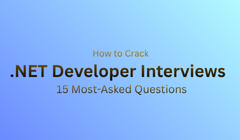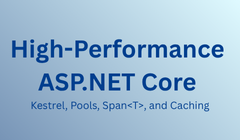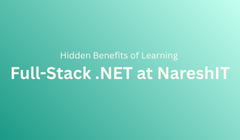
If you’re aiming for a .NET developer role whether you’re a fresher, transitioning professional, or mid-career developer being ready for the interview is more than just knowing syntax. It’s about understanding why things are asked, how to answer strategically, and how to weave your own experience into your responses.
This guide walks you through:
What interviewers really look for in a .NET candidate
15 most-asked .NET interview questions with sample answers and reasoning
Framing techniques to highlight experience, problem-solving, and readiness
FAQs to clear last-minute doubts
Practical next steps to strengthen your preparation
Before diving into the questions, understand what hiring teams actually evaluate. Knowing this helps you tailor every answer:
Strong fundamentals - Understanding .NET architecture, CLR, and memory management.
Practical application - Ability to show where you’ve used a concept in real projects.
Problem-solving mindset - Explaining how you debug, optimize, or handle production issues.
Clear communication - Explaining technical ideas simply and confidently.
Readiness to deliver - Employers look for candidates who can build, test, and deploy effectively.
Positive attitude - Showing curiosity and adaptability toward evolving .NET technologies.
Why they ask: To assess your foundational understanding.
Sample answer:
“.NET is Microsoft’s development platform supporting web, desktop, mobile, and cloud applications. Code is compiled into Intermediate Language (IL) and executed by the Common Language Runtime (CLR), which manages memory, type safety, and JIT compilation. The Base Class Library (BCL) provides reusable components for collections, I/O, and threading.”
Tip: Add a practical note “In my last project, I built microservices running on Linux containers using .NET 6 to leverage cross-platform capabilities.”
“The CLR executes IL code, manages memory through garbage collection, enforces type safety, and handles exceptions. It provides a managed environment so developers can focus on logic instead of memory management.”
Show understanding: “When diagnosing a memory leak, understanding GC generations helped me pinpoint large object allocations.”
“The .NET Framework is Windows-only. .NET Core introduced modular, cross-platform development. .NET 5+ unified both into one platform supporting all workloads. We migrated from .NET Framework 4.7 to .NET 6 to enable container deployment and performance gains.”
“GC automatically releases memory used by unreferenced objects. It organizes objects into generations (Gen 0, 1, 2) and collects short-lived ones more frequently. Monitoring GC behavior helps optimize performance in long-running services.”
Value types (structs, int) store data directly—usually on the stack—while reference types (class, string) store pointers on the heap. Use value types for lightweight objects that are short-lived to reduce GC pressure.
“DI provides objects their dependencies externally. ASP.NET Core offers built-in dependency injection via its service container. It improves testability and maintainability. For example, I registered IEmailService as scoped so each request got a clean instance.”
“async/await helps with non-blocking I/O, while threads handle concurrency. In ASP.NET Core, async I/O frees up threads for more requests, improving scalability.”
“EF Core is an ORM mapping databases to C# models. Common pitfalls include lazy loading, unpaged large queries, and not using AsNoTracking() for read-only operations. Optimizing these can significantly improve response times.”
“MVC follows Model-View-Controller for web apps with Razor pages, while Web API builds RESTful services returning JSON or XML. In one project, the admin UI used MVC while mobile clients consumed our Web API endpoints.”
Delegates are type-safe references to methods; events use delegates for pub-sub patterns; lambdas provide inline anonymous methods. Example:
Boxing converts a value type to object (heap allocation), unboxing reverses it. Avoid in performance-critical loops. Example: using List<int> avoids boxing compared to ArrayList.
Use layered handling: catch at repository level, wrap in domain exceptions, and centralize in global middleware with UseExceptionHandler(). Use ILogger<T> for structured logging and correlation IDs.
LINQ allows querying objects and databases with unified syntax. Queries without .ToList() are deferred—executed only when enumerated. Knowing this prevents multiple DB calls.
Reduce memory allocations (use structs, pooling).
Optimize queries and indexes.
Use async for non-blocking I/O.
Cache static data.
Profile and tune GC.
Configure hosting: enable server GC, compression, and caching.
For an in-depth technical view, explore High-Performance ASP.NET Core: Kestrel, Pools, Span<T>, and Caching on our blog.
“During a high-latency issue, I used dotnet-counters and Application Insights to find GC spikes. Refactoring large object allocations using ArrayPool<T> and pagination reduced response times by 65%.”
Don’t memorize; understand concepts deeply.
Use real examples — “I applied this in my project…”
Practice live coding (async, LINQ, EF).
Review the JD: emphasize relevant layers (frontend, backend, or full-stack).
Prepare your personal narrative: “Why .NET? What did you build?”
Q1. Which version should I focus on?
Ans: Concentrate on modern .NET 6/7+. Understand differences from legacy Framework versions.
Q2. Do I need to learn F# or VB?
Ans: No. Most roles require C#. Knowing others is optional.
Q3. What if I’m applying for backend only?
Ans: Still understand the basics of frontend interaction (APIs, JSON, CORS).
Q4. How can I stand out?
Ans: Quantify achievements (“Improved API latency by 30%”) and show end-to-end understanding.
Q5. Are algorithm questions common?
Ans: Expect moderate logic or data-structure questions. Enterprise roles focus more on applied .NET concepts.
Q6. How should I prepare in the last 7 days?
Ans: Review these 15 questions, rehearse mock interviews, and finalize your personal examples.
Cracking a .NET interview means showing readiness to design, build, and optimize. Knowledge matters but delivery matters more.
Pick 5 core questions and craft your custom answers.
Build or update a small full-stack project (UI + API + DB).
Conduct a mock interview focused on clarity and confidence.
On interview day, stay calm and communicate your thought process.
For structured learning and guided placement support, check out NareshIT’s Full-Stack .NET Developer Course, which includes real-time projects, interview prep, and mentor-led sessions designed to make you job-ready.

If you’re working with ASP.NET Core or looking to elevate your .NET web API performance, this guide is for you. We’ll explore four critical pillars: Kestrel server tuning, object/memory pooling, Span<T>/Memory<T> usage, and smart caching. You’ll leave with actionable techniques, best practices, and FAQs to help you apply or teach high-performance patterns effectively.
Performance isn’t only about making your app faster it’s about efficiency, scalability, and cost control.
In high-traffic systems (SaaS APIs, real-time microservices), even small inefficiencies multiply and waste CPU or memory.
Lower latency improves user satisfaction, reduces timeouts, and increases request capacity on the same infrastructure.
Optimized applications cut cloud costs by minimizing resource consumption.
Tuning often exposes deeper architectural flaws like thread pool starvation or GC pressure.
As explained in Microsoft’s ASP.NET Core Performance Best Practices, reducing allocations in hot paths helps maintain responsiveness and scalability.
In short: performance is a design principle, not an afterthought.
Kestrel is the default cross-platform web server in ASP.NET Core. It manages network I/O, connection handling, and HTTP pipelines. Proper tuning can significantly enhance throughput and reduce latency.
These settings, available in KestrelServerOptions.Limits, directly influence request concurrency, timeouts, and memory handling.
Increase MaxConcurrentConnections where hardware supports higher concurrency.
Tune KeepAliveTimeout and RequestHeadersTimeout for realistic workloads.
Use the modern Sockets transport (default in Linux) for superior performance.
Offload SSL and connection management to a reverse proxy such as Nginx or IIS for public apps.
Always benchmark changes with dotnet-counters or Application Insights before production rollout.
Every allocation increases GC pressure. Pooling helps reuse objects or buffers instead of constantly allocating and deallocating.
byte[] buffer = ArrayPool<byte>.Shared.Rent(4096);
try
{
int bytesRead = await stream.ReadAsync(buffer, 0, buffer.Length);
// Process data
}
finally
{
ArrayPool<byte>.Shared.Return(buffer);
}
This avoids frequent 4KB buffer allocations during streaming operations.
Pooling benefits high-throughput systems but requires careful handling—always reset state before reuse.
Span<T> and Memory<T> provide safe access to contiguous memory without allocating new arrays or strings. They are key tools for reducing GC pressure in performance-critical areas.
Parsing binary data or headers without creating temporary arrays.
Working with string slices via ReadOnlySpan<char> for trimming or tokenizing.
Streaming large payloads using Memory<byte> for async operations.
Use Span<T> in tight loops or frequently executed code paths.
Prefer Memory<T> for async or heap-safe use cases.
Avoid unnecessary boxing, closures, or LINQ in performance-critical sections.
Profile before optimizing measure GC and latency impact using BenchmarkDotNet.
Caching is one of the simplest yet most powerful optimization tools in ASP.NET Core. It cuts repeated database calls and speeds up common responses.
In-Memory Cache (IMemoryCache): Local to a process; extremely fast.
Distributed Cache (IDistributedCache): Shared between servers using Redis or SQL Server.
Response Caching Middleware: Stores entire responses for quick re-delivery.
Cache only semi-static or expensive-to-retrieve data.
Monitor hit ratios and memory usage.
In distributed systems, synchronize cache invalidation carefully.
Avoid caching excessively large objects.
To learn about detailed caching patterns, see Microsoft Learn’s ASP.NET Core Coaching Overview.
Baseline: Measure throughput, latency, and allocations before tuning.
Tune Kestrel: Adjust connection limits and timeouts.
Identify Hot Paths: Focus on endpoints with highest CPU or memory usage.
Apply Pooling and Span: Reuse buffers and reduce allocations.
Implement Caching: Use in-memory or distributed caching where suitable.
Load Test: Use wrk, k6, or JMeter for validation.
Monitor: Use Application Insights or Prometheus for live metrics.
Suppose you run a high-traffic e-commerce API:
You tune Kestrel to handle 2,000 concurrent connections.
Refactor image streaming using ArrayPool<byte> to avoid per-request buffer allocations.
Parse product feeds using Span<byte> to eliminate unnecessary copies.
Cache popular product responses in IMemoryCache for 30 minutes.
After tuning, GC allocations drop and latency improves by nearly 30%.
Q1. Do I always need to tune Kestrel?
Ans: No. Defaults are fine for moderate loads, but for high concurrency or API gateways, tuning helps reduce response time spikes.
Q2. Is object pooling suitable for all cases?
Ans: No. It adds complexity. Use it only when creating or destroying objects frequently causes noticeable GC overhead.
Q3. Should I cache everything?
Ans: Definitely not. Cache only expensive or frequently accessed data that doesn’t change often.
Q4. Can these techniques work in .NET 6 and above?
Ans: Yes. All principles apply to .NET 6, 7, and 8, which continue improving Kestrel, GC, and memory management performance.
High-performance ASP.NET Core development combines efficient memory management, tuned server settings, and strategic caching.
Kestrel tuning ensures optimal server throughput.
Pooling and Span<T> minimize memory allocations.
Caching reduces latency and database dependency.
Measurement validates real-world impact.
Keep your stack current with the latest framework updates. For structured, real-time learning, explore the NareshIT Advanced ASP.NET Core Performance Optimization Course, which covers practical profiling, caching, and scalability labs step by step.

When someone asks, “What will I gain from a Full-Stack .NET course?”, most answers focus on the obvious: C#, ASP.NET Core, SQL Server, UI frameworks, and deployment. But at NareshIT, the real value lies in benefits that are less visible advantages that make you more employable, adaptable, and future-ready.
In this blog, we explore five hidden benefits of NareshIT’s Full-Stack .NET Course, how they strengthen your learning and career, and why they truly matter. A detailed FAQ section follows to address common learner questions.
What it means
Many developers limit themselves to backend (C#, APIs, databases) or frontend (UI frameworks). NareshIT ensures you master both becoming a bridge between teams, not a siloed specialist.
Their course overview explicitly mentions coverage of “frontend technologies such as HTML, CSS, and JavaScript… along with robust backend tools like C#, ASP.NET, and SQL Server.”
Why it’s hidden but powerful
Versatility: You stand out as a developer who can manage UI, API, database, and deployment.
Team value: Understanding both ends minimizes friction and miscommunication.
Career growth: Mid-level and senior roles increasingly demand full-stack awareness.
Learning depth: Seeing how UI, backend, and DB interact helps you build production-grade apps.
How NareshIT supports this
Curriculum integrates both frontend and backend technologies.
Hands-on labs combine UI, API, and DB workflows.
Projects replicate real industry scenarios end-to-end.
Use case example
A student builds a “Student Placement Portal” developing UI (student filters), backend APIs (batch updates), SQL Server DB, and deploying it to Azure. When a recruiter asks, “Can you handle UI too?”, they can confidently demonstrate it.
What it means
A strong training brand with placement support ensures you get more than just technical knowledge you gain visibility and employability. NareshIT’s “Placement Assistance Program” for Full-Stack .NET highlights this commitment.
Why it’s hidden but critical
Recruiter trust: Employers recognise the NareshIT brand and value its credibility.
Job conversion: Placement assistance bridges the gap between training and employment.
Mock interviews and skill tests: You graduate job-ready, not just course-complete.
Alumni network: Career referrals and mentor guidance enhance placement opportunities.
How NareshIT supports this
Placement Assistance Program includes mock interviews, coding challenges, and soft-skills training.
Published outcomes like “3.5–6 L Avg Package” highlight successful placements.
Use case example
After course completion, you attend mock interviews, refine your resume with mentor feedback, and join placement drives organised by NareshIT translating learning into actual job offers.
What it means
Modern .NET (Core/5+/6/7) is a cross-platform, cloud-ready framework. NareshIT’s curriculum focuses on current technologies ensuring your skills remain relevant.
Why it’s hidden but extremely valuable
Longevity: Learning .NET Core gives you a skill that evolves with technology.
Cross-platform flexibility: Build and deploy on Windows, Linux, or containers.
Career range: Fit into backend, microservices, or DevOps roles.
Higher pay: Fewer developers master the latest frameworks, leading to better salary prospects.
How NareshIT supports this
Curriculum emphasises “.NET Core” and “cross-platform full-stack development.”
Projects cover cloud deployment, hosting, and version control.
Students use modern tools and frameworks used in industry today.
Use case example
You develop a web API using ASP.NET Core, containerize it, and deploy it via Azure App Service. You now speak the language of today’s cloud-enabled companies.
What it means
A true test of learning is the ability to show real work. NareshIT’s course structure ensures you complete portfolio-ready projects an invaluable asset in interviews.
Why it’s hidden but career-crucial
Proof of skill: Show working code instead of just claiming knowledge.
Confidence: Building and deploying a project boosts your technical confidence.
Better storytelling: Interviewers remember concrete examples of your work.
Differentiation: Most candidates only study modules your project proves end-to-end understanding.
How NareshIT supports this
“Practical Hands-On Projects” form a core part of the course.
Modules include deployment, CI/CD, and real-time scenarios.
Students maintain live GitHub repositories with complete application stacks.
Use case example
You finish a “Learning Management System” project, deploy it to Azure, and share your GitHub link with recruiters showing UI, backend, and DB integration with CI/CD.
What it means
Technical mastery thrives when supported by strong mentoring, flexible schedules, and continuous guidance.
Why it’s hidden but essential
Consistent learning: Access to mentors helps resolve doubts quickly.
Motivation: Group classes and coding challenges foster accountability.
Placement guidance: Resume building, soft-skill sessions, and mentoring ensure complete job readiness.
Flexibility: Live or recorded classes fit working professionals’ schedules.
Community: A peer network builds collaboration, motivation, and referrals.
How NareshIT supports this
“24/7 Support” and hybrid learning modes (live + recorded).
Dedicated placement and mentoring sessions.
Interactive challenges keep learners engaged.
Use case example
You balance part-time work and evening sessions. Missed a live class? You replay the recording. Stuck with a deployment issue? A mentor resolves it within a day. You stay consistent and confident.
| Hidden Benefit | Career Impact |
|---|---|
| Full-Stack Fluency | More job options, faster career growth |
| Brand Credibility & Placement | Higher shortlist rate, job conversion |
| Future-Proofing | Skills remain relevant for years |
| Portfolio Projects | Strong interview presence, confidence |
| Support Ecosystem | Fewer dropouts, faster results |
Together, these hidden benefits turn a training program into a career accelerator. NareshIT’s structured ecosystem ensures you not only learn .NET but evolve into a complete, job-ready professional.
Q1. Are these hidden benefits unique to NareshIT’s Full-Stack .NET Course?
Ans: Yes. The combination of full-stack curriculum, placement assistance, and real projects distinguishes NareshIT from generic online bootcamps.
Q2. I’m a working professional can I still access these benefits?
Ans: Absolutely. The course supports flexible learning through live and recorded sessions, plus 24/7 mentor access.
Q3. What if I already know backend .NET?
Ans: You’ll still benefit from the full-stack coverage, project focus, and placement ecosystem allowing faster upskilling and better employability.
Q4. How much is the average placement package?
Ans: The Placement Assistance track lists 3.5–6 LPA as the average package range, varying by city and experience.
Q5. Is this course future-relevant for 2025–26?
Ans: Yes. With its focus on .NET Core, cloud readiness, and deployment practices, the curriculum aligns with evolving market needs.
When evaluating a training program, don’t just ask what technologies you’ll learn ask what competitive edge you’ll gain.
The Full-Stack .NET Course at NareshIT offers five hidden advantages: full-stack fluency, placement-backed credibility, modern cross-platform skills, hands-on project experience, and a strong support ecosystem.
Together, these transform you from a learner into a professional who can code, deploy, collaborate, and communicate with confidence.
To explore more about real-time projects and placement opportunities, visit the NareshIT Full-Stack .NET Training with Placement Assistance page for detailed curriculum insights and enrolment options.